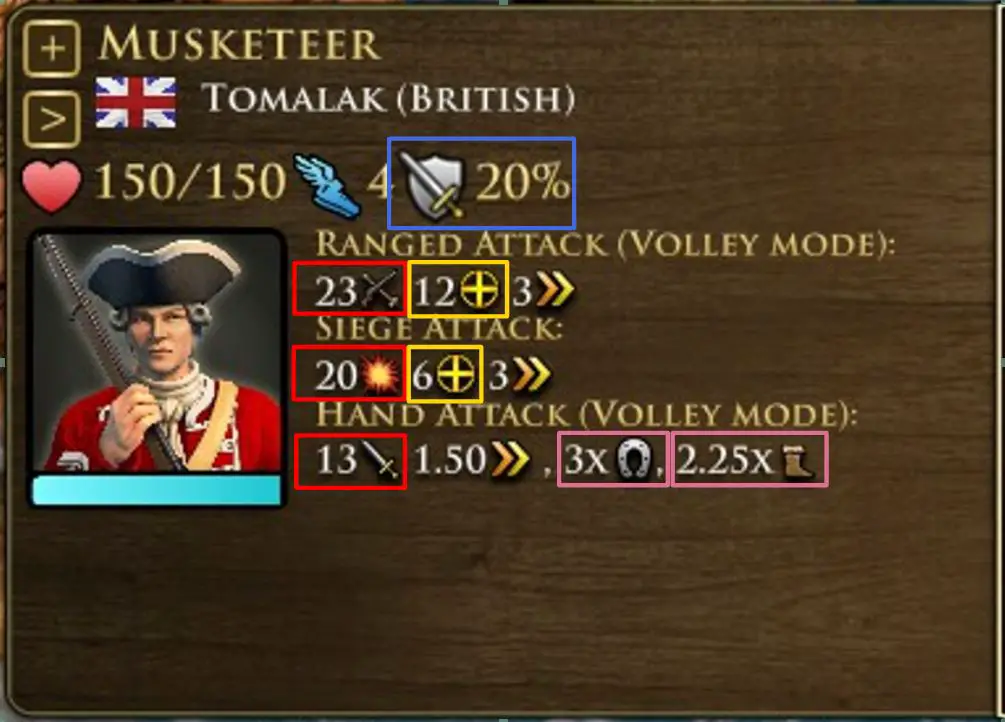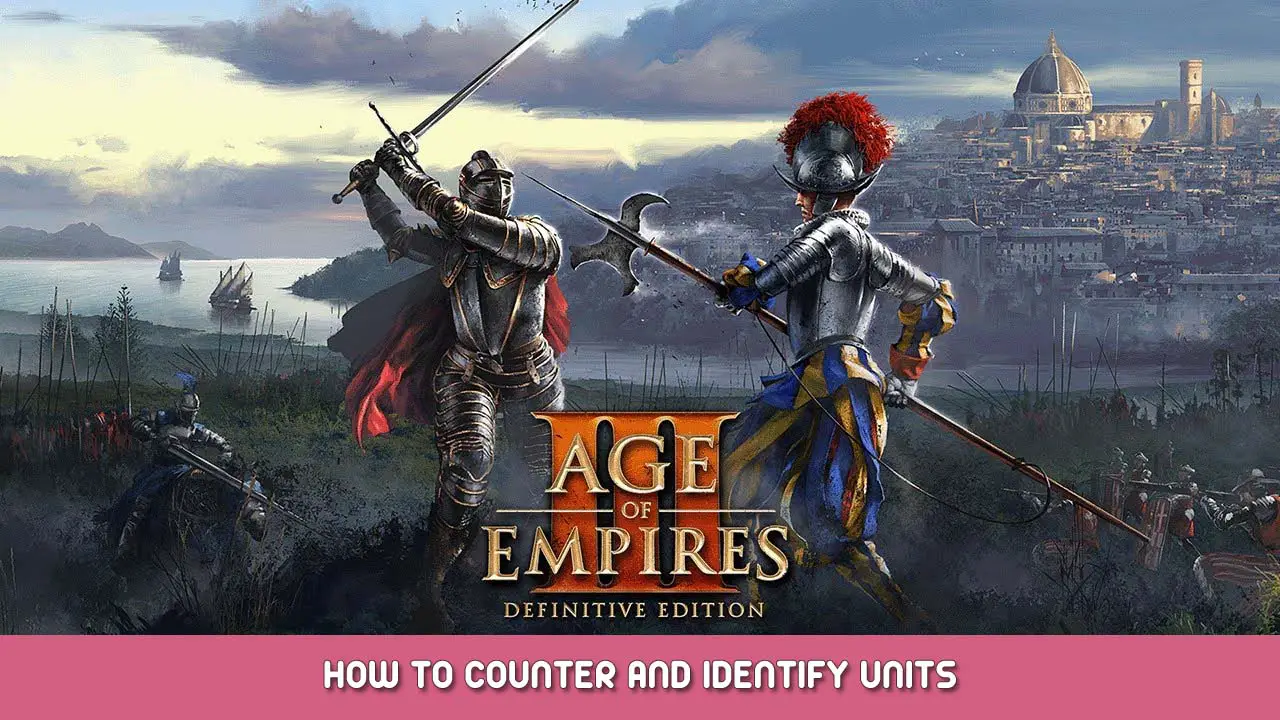Explanations & Rules of thumb about the tag-based counter system, covering exceptions and exotic units.
Preamble
Praca w toku:
Notatka: Most important aspects should be covered already, however it should be stated that:
Not Covered yet / To do:
- Resistances in various Stances
- Charged Attacks / Variing speed Attacks
- “Egzotyczny” Units in detail (Own section)
- Most noteable “non-exotic” Units in detail (Own section)
- Outlaw Units (will be implemented in existing sections)
- Revolutionary Units (will be implemented in existing sections)
If you have any questions, suggestions, critics or found any mistakes, especially forgotten exceptions not mentioned above, please make liberal use of the comment section!
Wstęp
I think its quite easy being said that one of AoE III greatest features and biggest bane is its continously growing variety of more or less unique units. (~200 I think)
Especially with the last update of October making anti-intuitive units easier accessable – this guide is proposed to aid new as experienced players to easier get along without knowing every single unit.
Assuming you are not able to completely out-micro, out-number, or out-tech your enemy, which will be the vast majority of the time, you will have to bother about what type of unit is best against what other type.
In AoE III units are defined by tags and so are most of their strenghs and weaknesses.
Tagi are important, since most Units deal dodatkowe obrażenia Do specific tagged jednostki.
Kusza I Skrimishers deal extra damage (1.25 Do 3 czasy) Do Heavy Infantry I (2.0 czasy) Lekka kawaleria Na przykład.
From all unit tags jak na przykład:
Piechota, Light Infantry, Heavy Infantry, Ranged infantry, Musket Infantry, Archaic Infantry, Cavalry, Heavy Cavalry, Siege Units, Artilery, Native Units, Mercinaries,… – I could continue this further but I think you agree that there are many of them.
Not all Tagi are equally important. W rzeczywistości, you actually don’t ultimately have to bother too much with them, since there are some simple rules to easly see (by klicking on the Unit) what it is strong and what it is weak against.
Przykład (1)
In the tool tipp below you can see primary stats like
Zdrowie, Szkoda, Attackspeed, Movementspeed;

Ale także:
Opór: Blue Bracket
Szkoda & Rodzaje uszkodzeń: Red Brackets
Zakres: Yellow Bracket
Multipliers: Rosa Brackets
This Musketeer for example got: Melee Resistance, Ranged Attack z no multipliers,
Siege Attack (Only usable vs buildings) z no multipliers I Melee Attack z [3x VS Cavalry] I [2.25 VS Shock-Infantry] multipliers.
Przy okazji: You don’t need to know the symbols – simple mouse-over will tell you the meaning.
While being self tagged as:

(You can get this window by mouse-over the portrait of the previous tooltip screen)
Here we can see it is:
–Piechota
–Ranged Infantry
–Heavy Infantry
What does it mean?
- With its Melee-Resistance To powinien perform well against all units that deal Melee-Damage.
- Its Ranged Attack dostałem no multipliers – so that is neither especially good or bad.
- Its Melee-Attack however got 2 different multipliers: 3x Cavalry – meaning it will deal
3 times the damage to every unit tagged as Cavalry I 2.25 czasy the damage against as Shock Infantry tagged units.
So this is a unit that powinien do well against Cavalry I Shock Infantry in Melee – since it takes less Melee Damage and deals more to this type of units.
While on range it is more allround.
Notatka: Shock Infantry looks like Piechota but is technically not tagged as such, which fulfills the role of (głównie) Heavy Cavalry – and is usually also treated alike by other units -> Artyleria deals mniej uszkodzeń Do Cavalry & Shock Infantry and so on. Shock Infantry is typical for Native American factions but in particular for the Aztec as they lack any type of classic Cavalry
Rules for easier identification of Tags & Unit-Types
Niektóre Basic-Rules
- If it got a ranged attack – it is its primary attack.
- If it got a ranged attack it deals ranged damage with its ranged attack.
- If it got melee attack it deals obrażenia wręcz with its melee attack
Niektóre other Rules
- If it got a piky end (speers, bajonets, swords…) – To jest Heavy Infantry Lub Heavy Cavalry
- Jeśli to shoots arrows – it is Light Infantry Lub Lekka kawaleria
- If it got a musket and is mounted – Jego Lekka kawaleria
Notatka: The Rules above are not reverse applicable (there is some Heavy Infantry without piky ends) and can only be applied for units in their standard stance, Longbowmen for example use swords if forced or set to melee stance but are still Light Infantry
Furthermore regarding Infantry:
- Jeśli tak jest tylko fighting in Bijatyka it is Heavy Infantry Lub Shock Infantry and countered by Heavy Ranged Infantry but not only.
- If it got Melee Resistance it is Heavy Infantry
- If it got Ranged Resistance it is Light Infantry
For exceptions see the “Systematics of Units” section below.
Basic Counter-System: Głaz, Papier, Nożyczki
In AoE III we got a fairly complex counter-system, consisting of many different types of units countering other units, what makes it sometimes possibly counter even mixed armies with a single type of unit.
However there are some rules applicable most of the time:
Rough Counter-Rules:
- Piechota zabija Cavalry (neglecting light infantry like Bowmen & light Cavalry)
- Cavalry zabija Artyleria
- Artyleria zabija Piechota (neglecting some exotic units)
A little bit less rough Counter-Rules:
- Light Infantry zabija Lekka kawaleria & Heavy Infantry
- Heavy Infantry zabija Heavy Cavalry & Heavy Infantry
- Lekka kawaleria zabija Heavy Cavalry & Artyleria
- Heavy Cavalry zabija Light Infantry & Artyleria
- Artyleria zabija Light Infanrty & Heavy Infantry
Systematics of Units
Piechota
- Exceptions(1) Urumi (Tylko Piechota neither Światło- or Heavy)
- Heavy Infantry
- Atak: Ranged and/or Melee
- Exceptions(1): Inquistor(Siege Damage on quasi Melee Attack)
- Amor: Only Melee
- Exceptions(5): Carolean(dystansowe), Papal Guard(dystansowe), Nizam-Fuslier(Oblężenie), Yamabushi(dystansowe), Desert Warrior(Switching)
Notatka: The Carolean starts like a normal musketeer with Melee Amor and switches it only once and irrevesible to dystansowe after the age IV homecity card: “Svea Lifeguard” is sent.
- Exceptions(5): Carolean(dystansowe), Papal Guard(dystansowe), Nizam-Fuslier(Oblężenie), Yamabushi(dystansowe), Desert Warrior(Switching)
- Atak: Ranged and/or Melee
- Light Infantry
- Atak: Only Ranged
- Exceptions(2): Sudanese Dervish(Melee on range), Dhaomey Amazon(Melee on range)
- Amor: Only Ranged
- Exceptions(4): Arrow-Knight(Oblężenie), Huraca(Oblężenie), Darood(Oblężenie), Pavisier(Switching)
- Atak: Only Ranged
- Shock Infantry
- Atak: Only Melee
Exceptions(1): Eagle-Runner Knight - Amor: Only Ranged
- Exceptions (0): nic
- Atak: Only Melee
Notatka: Despite being here listed under “Piechota”, the tag Shock Infantry Jest mutually exclusive z Piechota and in general far more similiar Do Cavalry
Cavalry
- Heavy Cavalry
- Atak: Only Melee
- Exceptions(1): Yojimbo
- Amor: Only Ranged
- Exceptions (2): Sennar Horseman, Lifidi-Knight
- Atak: Only Melee
- Lekka kawaleria
-
- Atak: Only Ranged
- Exceptions (1): Berber Camel Rider
- Amor: Majority Ranged
- Exceptions (7): Cavalry Archer, War Wagon, Bow Rider, Black Rider, Manchu, Berber Camel Rider, Comanche Horse Archer
- Atak: Only Ranged
So in total out of ~200 units there are only ~24 “weird” combinations of Tagi, Oporności I Attack Types
To wszystko, co dzisiaj udostępniamy w tym celu Age of Empires III: Wersja ostateczna przewodnik. Ten przewodnik został pierwotnie stworzony i napisany przez Tomalak. Na wypadek, gdybyśmy nie zaktualizowali tego przewodnika, możesz znaleźć najnowszą aktualizację, postępując zgodnie z tym połączyć.
